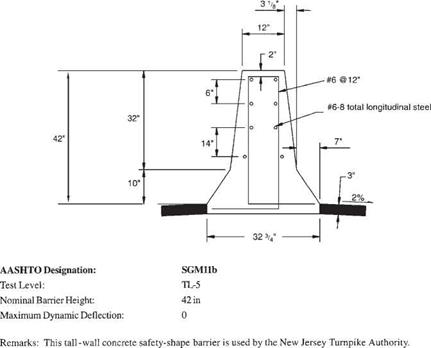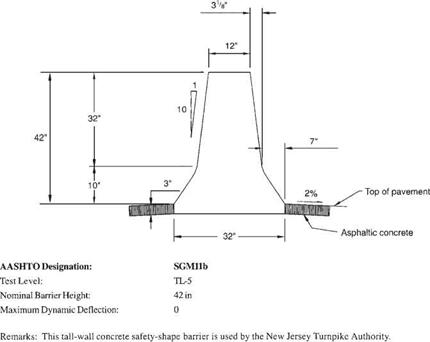PLACEMENT OF BARRIERS ON SLOPED MEDIANS
Either roadside barriers or median barriers may be appropriate for sloped medians, depending on conditions. If a relatively flat median (slope of 1:10 or flatter) free of rigid objects is available, a median barrier can be placed at the center. When such desirable conditions are not available, some additional guidelines should be considered. Figure 6.36 shows three basic types of median sections. Section I (illustrations 1-3) represents a depressed median or one with a ditch; section II (illustrations 4-6) represents a stepped median or a median that separates traveled ways with significant differences in elevation; and section III (illustration 7) applies to a raised median.
Section I. Check to see if the slopes warrant a barrier. If both slopes require shielding (illustration 1), place a roadside barrier near the shoulder on each side of the
|
FIGURE 6.32 Tall-wall concrete safety-shape (reinforced) median barrier. Conversion: 1 in = 25.4 mm. (From Roadside Design Guide, AASHTO, Washington, D. C., 2002 and 2006, with permission) |
median. If only one slope must be shielded, place a median barrier near the shoulder on that side; use a rigid or semirigid barrier, and install a rub rail on the ditch side of the barrier to prevent snagging of a vehicle that has crossed the ditch. If neither slope requires shielding but one is steeper than 1:10 (illustration 2), place a rigid or semirigid median barrier on the side with the steeper slope when warranted. If both slopes are relatively flat (illustration 3), place a median barrier (any type with dynamic deflection not greater than half median width) at or near the center of the median if vehicle override is not likely.
Section II. If the embankment slope is steeper than 1:10 but traversable (illustration 4), place a median barrier near the shoulder on the high side of the slope. If the slope is not traversable (such as a rough rock cut, illustration 5), place a roadside barrier at the top and bottom of the slope. If a retaining wall is located at the bottom of the slope, contour the base of the wall to the exterior shape of a concrete safety shape. If the slope is flatter than 1:10 (illustration 6), place a median barrier near the center.
Section III. If the median is sufficiently high and wide (illustration 7), vehicles may be redirected without a barrier. If the slopes are relatively flat and traversable, place a semirigid median barrier at the apex. If the slopes are not traversable, place a roadside barrier on either side.
When a median barrier is warranted, it is best to use the same barrier throughout the length of need. In cases where a roadside barrier is required on both sides of the median
|
FIGURE 6.33 Tall-wall concrete safety-shape (unreinforced) median barrier. Conversion: 1 in = 25.4 mm. (From Roadside Design Guide, AASHTO, Washington, D. C., 2002 and 2006, with permission) |
for some length and a centrally located median barrier is situated upstream and downstream, use a gradual transition between the systems proceeding in the direction of traffic.








Leave a reply